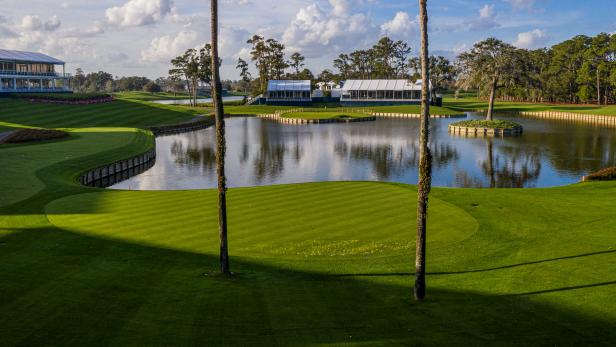The island green at TPC Sawgrass comes with a few ready-made adjectives. Famous. Is No. 17 the most notorious hole in American golf? If not, it’s safely inside the top five. Foreboding. Nobody wins the Players Championship without making his peace at the island green, and we’ve seen dreams shattered in the surrounding water. Feared. From the high stakes of a Sunday in March to the low stakes of a buddies trip with three smartphones filming, facing down the 137-yard tee shot is about as tremor-inducing as it gets.
Everything we’ve just described, though, is more about image than reality. When you cut past the aura of the legendary hole, you’re left with a question: How hard is it, really, from a statistical point of view? We tackled this question from a few different directions, and in a few of them we tried to take water out of the equation … only to discover that you can’t take water out of the equation, even when you do.
But that’s getting ahead of ourselves. First, we reached out to Luis Rivera at the PGA Tour, who provided us with some useful data. According to Rivera, from 1983 to 2019, players averaged a 3.12 at 17 (or, if you’re a sadist, 1,771 over par across a 37-year stretch). Unlike what you might expect on many par 5s on tour, players haven’t really gotten better over time at 17, and there have only been five years (1987, 1994, 1996, 1997 and 2014) when the collective average was under par. It has ranked as the eighth-hardest hole on the course since 2003, though it boasts the most triple bogeys or worse. Players are equally likely to make birdie (17 percent) as they have been bogey or worse (18 percent) in that time, and while it has the second-highest greens-in-regulation number of any hole at Sawgrass (79.7 percent), it has the toughest scrambling percentage … which makes sense since it’s not easy to scramble from the bottom of a lake. Meanwhile, there have only been nine aces on the hole since 1983, and Fred Couples (1997) is the only one to do it in the final round.
That all sounds tough, but how does it compare to other par 3s of comparable length on tour? To answer that question, we looked at 55 other holes that fell between 120 and 142 yards, using the strokes-gained era of 2004 to the present. Those parameters were chosen because the average length of all 55 equaled, almost exactly, the average length of 17 (135.4 yards). We’ll call those 55 holes the “control group.” Here are a few key findings:
• The average score at No. 17 was 3.12. That was significantly worse than the average of our 55-hole control group, which came in at 2.91.
• The birdie percentage at Sawgrass (16.5) was correspondingly lower than the control group’s 21.2.
• The par and bogey rates were actually quite similar, but the “double bogey-or-worse” percentage was close to 8 percent at 17 while it didn’t crack 1.5 percent with the control group. Again, water will do that to you.
• Perhaps most surprisingly, the greens-in-regulation percentage—which on a par 3 just means you reached the green with your tee shot—was higher at Sawgrass (80.0 percent) than the control group (76.9 percent).
This brought us to the point where we wanted to do everything we could to remove water from the equation. Nearly 10 percent of golfers (9.9 percent) hit into the water at TPC Sawgrass—the high-water mark, pun intended, came in 2017, when 19.2 percent of players dunked their first shot during the tournament—compared to 1.7 percent who incurred a penalty off the tee shot in the control group (where the vast majority of holes did not have water). Of course that accounts for at least part of the higher scoring rate. The question that remained unanswered was: What if there was no water? Or, more accurately, is the water the only thing that makes No. 17 hard?
In an attempt to answer that, we ran some comparisons using only the shots in each group that qualified as a “green in regulation” (again, tee shot ends on the putting surface). Our findings:
• Even when controlling for greens in regulation, the median proximity to the hole at No. 17 was 22.5 feet, while that same number in the control group was 16.7 feet. Fully 55 percent of players who reached the green in one at Sawgrass found themselves at least 20 feet away from the hole, compared to 39 percent in the control.
• As you might guess, this led to higher one-putt rates in the control group (27 to 20 percent) and higher three-putt rates at Sawgrass (6 to 3 percent).
That means that even when comparing GIR-only shots, the average score at Sawgrass was 2.87, or 0.1 higher than the 2.77 mark from the other 55 holes.
If we go back to our earlier comparison numbers, which showed an overall difference of 0.21 strokes between No. 17 and the control group (3.12 to 2.91), and an overall difference of 0.1 strokes given a green in regulation (2.87 to 2.77), we can fairly make the following conclusion:
The water at Sawgrass makes it 0.11 strokes harder than par 3s of comparable length, and the worse proximity on greens in regulation accounts for the other 0.1 strokes.
But—you knew this was coming—it’s still not that simple, is it? The next question you have to ask is why the proximity is worse on greens-in-regulation shots, and though we aren’t mind-readers who can get into the heads of every player, it’s obvious that even here, water plays a massive role. If the penalty for attacking the pin is so severe, then players are more likely to aim for the center of the green, farther from the hole. That’s what we meant earlier when we said that even when you take water out of the equation, well … you can’t take water out of the equation. In that sense, you can attribute most or all of the 0.21 stroke difference to the water.
As a visual illustration, look at this scatter chart from the final rounds of 2017, 2018, and 2019 combined, with the pin in its traditional right, tight-by-the-water Sunday position. Green dots are one-putts, yellow dots are two-putts, red dots are worse (and notice the total lack of balls on the golfer’s left ridge well over the flag):
As you see, a “safe” shot keeps you far away from the pin, and where you might see more players target the pin if the penalty was simply being in the rough, the water increases the danger factor considerably. Hence, water dictates average proximity.
How difficult is No. 17, then? Well, by the standards of short par 3s, the answer is “very difficult.” Rivera at the PGA Tour crunched the numbers for all holes shorter than 150 yards, and by stroke average, TPC Sawgrass’ 17th is the hardest. No. 8 at Royal Troon (3.09) and No. 12 at Whistling Straits (3.02) are the two that have come closest, but the island hole tops them all. It’s also the most penal when you miss the green, with a 4.08 average (5.04 for water balls) that beats No. 15 at PGA National (3.82) and No. 11 at TPC Southwind (3.81).
Numbers like that are going to hurt a lot of innocent golfers, and that’s also something we can quantify. Bob Tway had the worst single-hole score, posting a 12 in 2005. Scott McCarron has the worst career GIR percentage, hitting the putting surface in just 6 of 16 tries. Aaron Baddeley, poor man, has the most water balls, with 13 to his “credit.” Phil Mickelson is tied for second at nine, while Sergio Garcia and Brooks Koepka each have eight.
We also know who handles the island stress the best. Bernhard Langer has the most career birdies with 26 (oddly, Mickelson is tied for third with 18, meaning he’s a particularly feast-or-famine performer on 17). Adam Scott and Garcia (see Mickelson note in previous sentence) have the most since 2008, with 15 apiece. Tom Lehman has the best scoring average (2.82) for a career, while Johnson Wagner (2.71) is the best since 2017. Graham DeLaet and Chez Reavie are the GIR wizards, both of them 18-for-18 in their careers (in a smaller sample, Bryson DeChambeau is 8-for-8).
As the numbers show, though, success stories are more the exception than the rule. In general, this is a game where the water wins. That’s the final secret element of No. 17, the one that comes after the fear and foreboding, and the one statistics can hint at but never quite measure: pain. The island life isn’t for everyone.

